The Samsung Galaxy Z Flip’s headline feature is its folding 6.7-inch AMOLED display, which bends in the middle with no visible hinge on the screen. It’s a neat trick, and there are only a handful of phones that can do it. Apart from that, its essential specs are in line with a flagship phone in 2020: a cutting-edge Qualcomm 855+ processor, 8GB of system memory, and 256GB of internal storage.
On paper, the camera is less obviously high-end. There are a pair of modules on the back, each with a 12MP sensor—and this at a time when high-end phones might have three or even four rear-facing cameras and higher-resolution sensors. The primary module has a 27mm-equivalent f/1.8 lens with dual pixel phase detect autofocus (PDAF) and optical image stabilization (OIS). The wide camera seems more impressive, with a 12mm-equivalent f/2.2 lens that is wider than most. A tele-camera is conspicuously absent.
Samsung does appear to care about the Flip’s photographic chops, though. Marketing materials point out that the neo-flip-phone form factor opens up interesting shooting possibilities such as using the half-folded phone as a built-in tripod for getting in on the action or for taking long exposures. A mode called Night Hyperlapse records timelapse video clips in low light, something you’d definitely need a stable shooting platform to do right.
While the spec sheet doesn’t suggest a photographic barn-burner, quantity isn’t everything in the smartphone camera game—consider the Google Pixel 4, which manages quite well with its two moderately-spec’d cameras. Find out how much imaging performance Samsung can squeeze out of its folding phone in our DXOMARK Camera review.
Key camera specifications:
- Dual-camera setup
- Primary: 12MP 1/2.55-inch sensor, 27mm-equivalent f/1.8-aperture lens, dual pixel PDAF, OIS
- Ultra-wide: 12MP sensor, 12mm-equivalent f/2.2-aperture lens
- LED flash
- 4K video at 30/60fps
About DXOMARK Camera tests: For scoring and analysis in our smartphone camera reviews, DXOMARK engineers capture and evaluate over 1600 test images and more than 2 hours of video both in controlled lab environments and in natural indoor and outdoor scenes, using the camera’s default settings. This article is designed to highlight the most important results of our testing. For more information about the DXOMARK Camera test protocol, click here. More details on how we score smartphone cameras are available here.
Test results


With a DXOMARK Camera overall score of 105, the Samsung Galaxy Z Flip places in the middle of the top twenty smartphones in our database. It’s a respectable performance in general, scoring just behind Apple’s iPhone XS Max, which held the second-place slot in our tests two years ago. Ordinarily, we would expect more from a flagship phone with the Flip’s pricing, but it’s not necessarily fair to compare it to mainstream slab designs. Arguably, there’s only one direct competitor to the Flip at the moment—Motorola’s new take on the RAZR, with its clamshell screen, which we have not yet tested.
The Flip’s camera nails down the basics, with accurate exposures and generally accurate white balance.

The phone also usually handles high-contrast scenes well, delivering good dynamic range, though we did note some highlight and shadow clipping in extremely contrasty situations.



In most situations, including indoors, the Flip delivers pleasant color rendering, though in outdoor scenes colors are sometimes a bit desaturated.
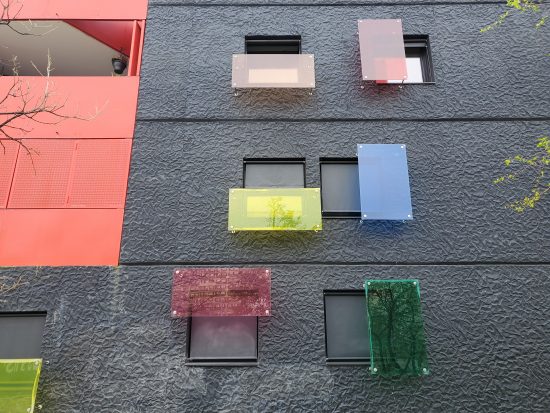

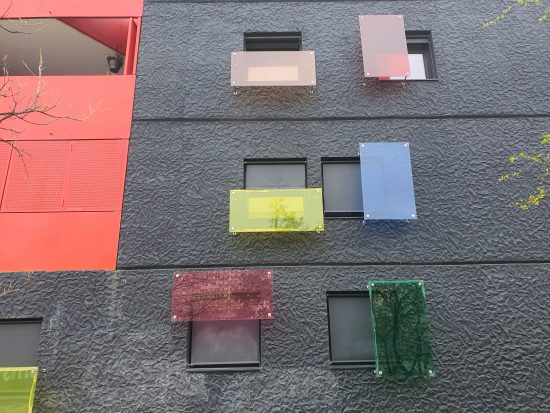
The Samsung Galaxy Z Flip controls noise fairly well both indoors and out. Though sometimes visible, noise is not intrusive. Outdoors in good light, the Flip usually successfully juggles noise suppression and detail retention, delivering photos with good texture and low noise. In the comparison below, all three devices do very well in this respect.
In some situations the Flip needlessly sacrifices detail, however, smoothing away texture that other phones manage to retain.
The Flip’s autofocus performance is a mixed bag. The good news is that it’s accurate and consistent, but the bad news is that it’s slow—disappointing, since AF speed is not usually an issue for high-end phones today. In the chart below showing low-light AF speed, the Flip’s performance lags well behind the other phones, as it did in all tested conditions.
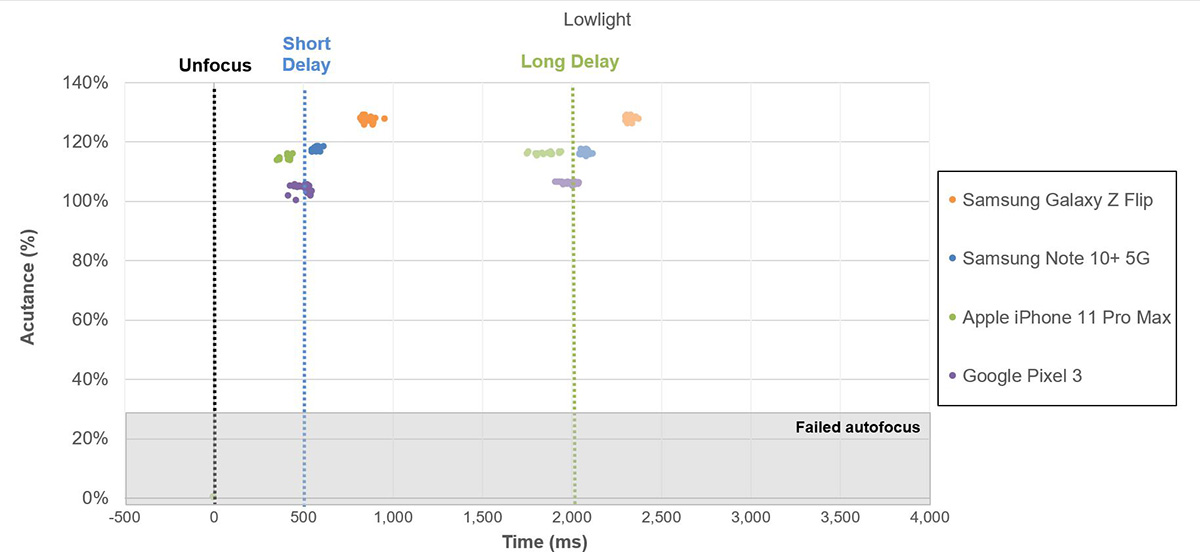
The Samsung Galaxy Z Flip earned an Artifact sub-score of 70, which is not bad, but hardly class-leading. Strong ringing artifacts are common, and softness creeps into the corners of the frame. Flare, ghosting, color fringing, and moiré occasionally crop up.
The Galaxy Flip Z’s ultra-wide camera earns a very good Wide sub-score of 43 in our testing, besting many phones that have higher overall camera scores (including the current top spot holder, the Huawei P40 Pro). It has a 12mm-equivalent focal length, which is wider than many other phones, so you can pack a lot into the frame. Colors are pleasant, exposure is accurate, and dynamic range is wide both indoors and out.
On the downside, color fringing is often visible, ringing artifacts show up on high-contrast edges, and we noticed fusion artifacts (errors when merging multiple frames) when testing indoors.
In this comparison, you can see that like the Samsung device, the Flip’s 12mm lens allows you to squeeze a little more content into the frame than the Apple’s 13mm lens (13.7mm measured); by contrast, Huawei’s flagships offer much narrower ultra-wide lenses at 18mm.
While the Flip is happy to go wide, it’s not so keen on going long. Dedicated tele-camera modules are becoming standard on high-end phones, but the Flip goes without, with predictable consequences for its Zoom sub-score in our testing—a rather dismal 30. Without a tele module, and apparently without any fancy tricks like Google’s Super Res Zoom, zooming with the Flip is a simple matter of cropping and upsampling image data from the main camera. The results aren’t pretty, with detail dropping quickly as the zoom factor increases, along with visible noise and strong ringing artifacts as the sharpening algorithms grind on less and less visual information.
The Flip earns a middling Bokeh sub-score of 50, behind the performance typical of high-end phones. Depth estimation artifacts are present—for example, sometimes the algorithm will keep the subject’s face sharp but blur the body. On the plus side, the shape of the bokeh is usually nice and noise is evenly distributed (some phones blur away noise when simulating background blur, which makes the subject look unnaturally noisy). However, the blur gradient itself sometimes looks unnatural.
When the lights go down, the Galaxy Z Flip does a reasonably good job with flash portraits, setting good subject exposure while allowing the background to burn in a bit so it’s not just a black void. On closer inspection, though, detail is low and noise is high.
Night-time cityscapes are not too impressive, with low levels of detail and a fair amount of noise. If left on its own, the Flip will sometimes fire its flash in an attempt to light your city shot (this is usually not a good idea). This said, detail and noise are on a similar level as for the iPhone 11 Pro Max. The Note 10+ 5G records less detail than the Flip, but delivers a cleaner image.
When it comes to shooting video, the Galaxy Z Flip delivers vivid, pleasant colors and accurate exposure. In a welcome change from the phone’s stills performance, autofocus is plenty quick and remains consistent. Outdoors, stabilization is quite effective. Its overall video score of 96 is good, even if it lags a bit behind many of the latest high-end phones.
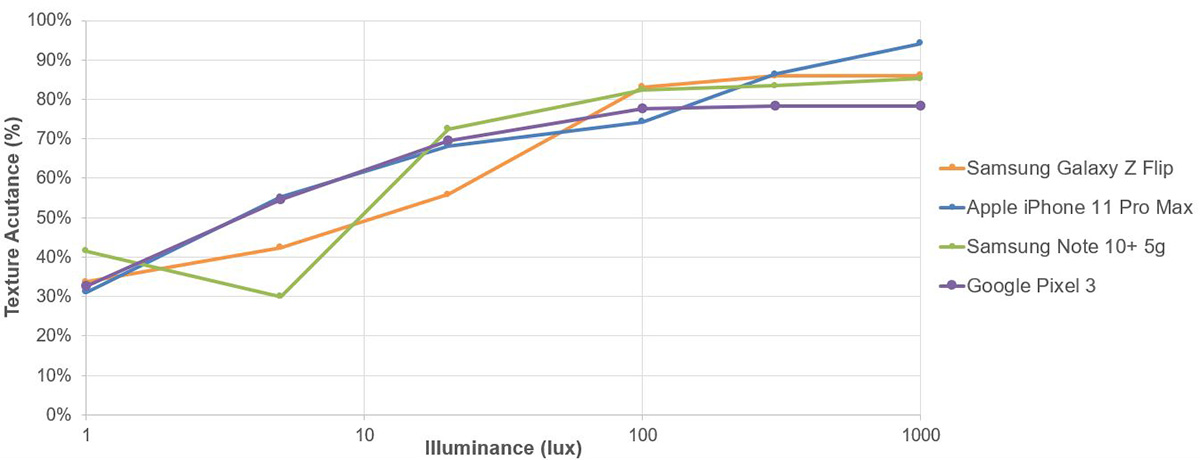
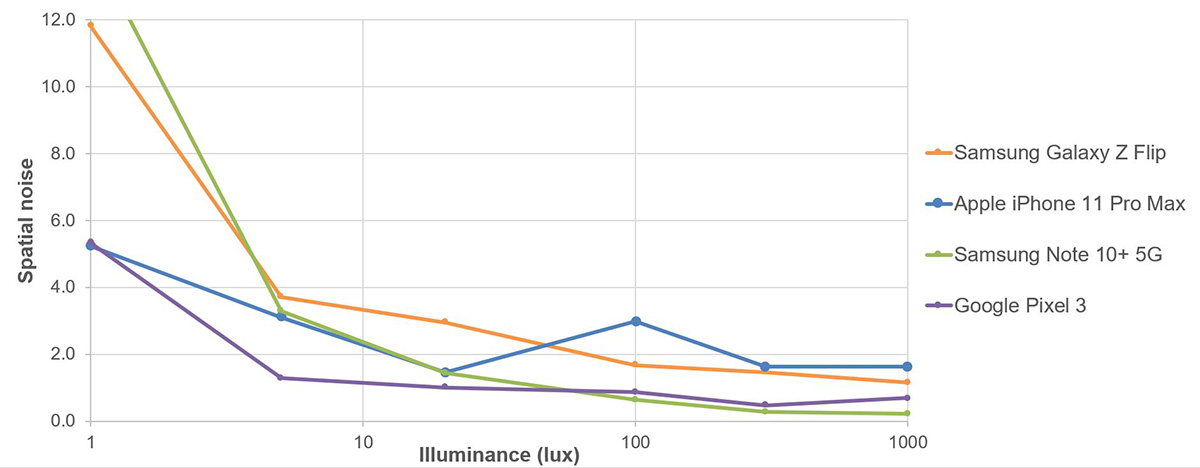
On the downside, dynamic range is remarkably restricted, something you’ll need to keep in mind when shooting high-contrast scenes. Strong luminance and chroma noise also degrade image quality in all conditions, with low light unsurprisingly the worst case. Testing also revealed that although stabilization works fine outdoors, it’s another story inside, with marked jerkiness marring output in our walking video test. Sharpness sometimes varies in tracking shots, and we also observed an unusual artifact where part of the frame appeared unfocused despite being in the plane of focus.
Conclusion
When it comes to the Samsung Galaxy Z Flip, the star of the show is that folding screen, and your take on the phone’s premium price tag is more about what that feature means to you than anything else. The Flip’s imaging system is far from an afterthought, but it doesn’t really compete with the best available cameras in other phones in its lofty price bracket (including Samsung’s other flagship devices).
With generally pleasant colors, wide dynamic range, and fairly well-controlled noise, the Flip’s main camera gets a lot right. Its ultra-wide performance is very good, despite some artifacts. But the shooting experience is let down by slow autofocus, and at a time when huge strides are being made in zoom performance on phones with tele-camera modules, the Flip’s lack of one is sorely felt. Video quality is generally good, but dynamic range (a strength in stills shooting) is remarkably bad—and that, along with high noise and some distracting artifacts, holds performance back.
If you love the form factor, the Flip’s cameras should not turn you off, but if this new/old phone design takes off, there will be room for offerings with better imaging performance.
Photo
Pros
- Dynamic range is fairly wide under all conditions
- Color rendering is generally pleasant and white balance is accurate
- Noise is generally well controlled
- Nighttime exposures are usually accurate
- Wide shots have nice color and accurate exposure
Cons
- Detail levels are sometimes low
- Strong ringing artifacts frequently visible
- Autofocus is slow
- Depth estimation artifacts frequently visible in bokeh simulation
- Wide camera exhibits ringing and color fringing, fusion artifacts when indoors
Video
Pros
- Colors are vivid and pleasant
- Focus is usually fast and consistent
- Stabilization is effective outdoors
Cons
- Strong luminance and chroma noise, especially in low light
- Dynamic range is very limited
- Sharpness can vary frame to frame, especially indoors
- Unusual partial focus artifact sometimes visible in tracking shots


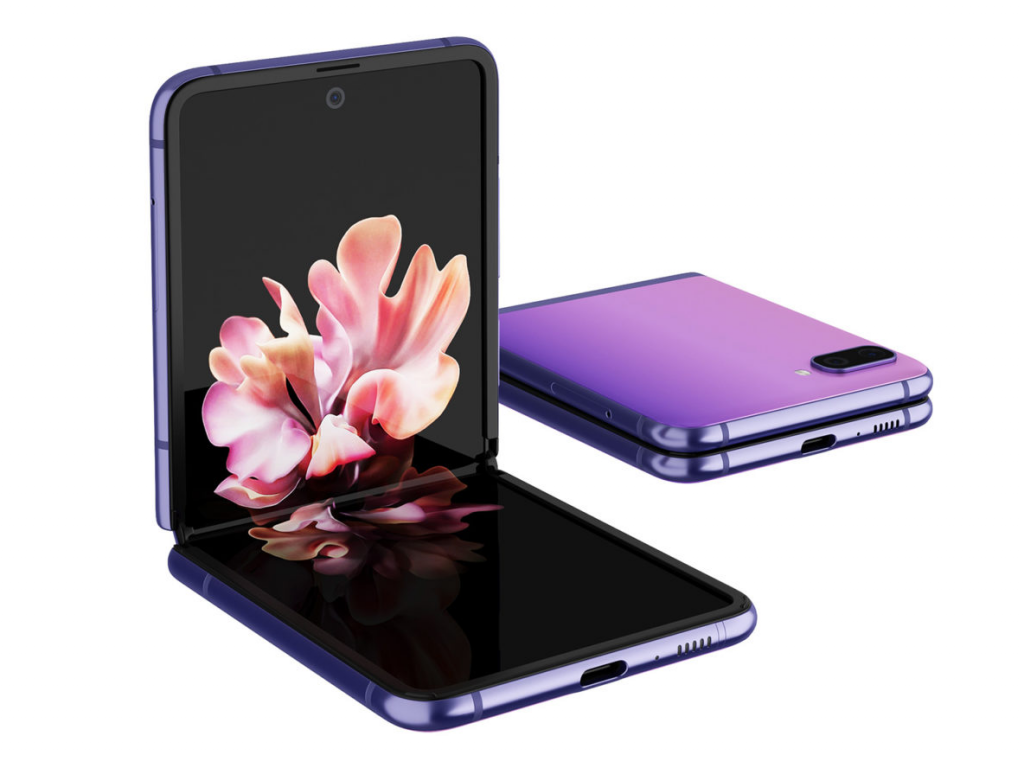






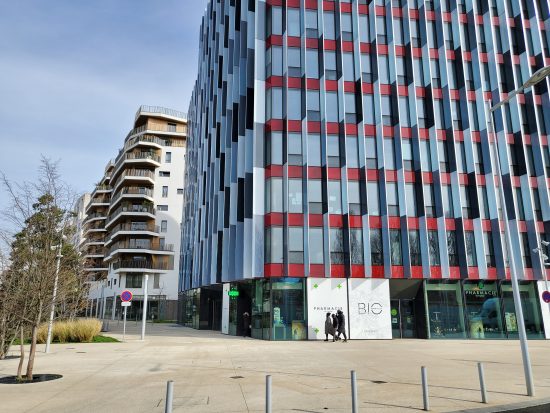



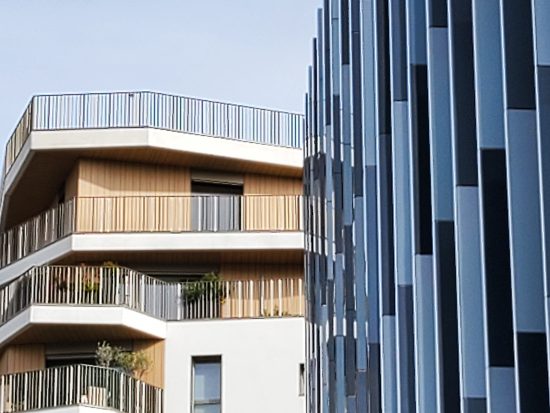
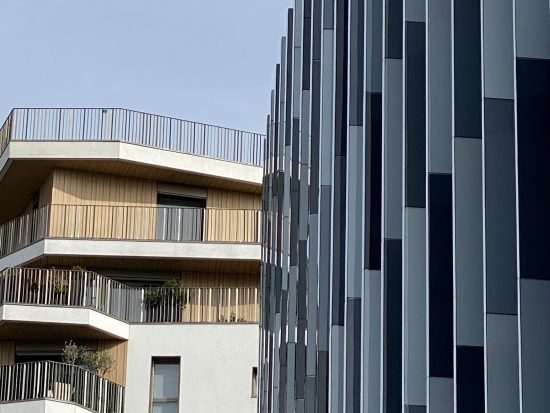









DXOMARK encourages its readers to share comments on the articles. To read or post comments, Disqus cookies are required. Change your Cookies Preferences and read more about our Comment Policy.